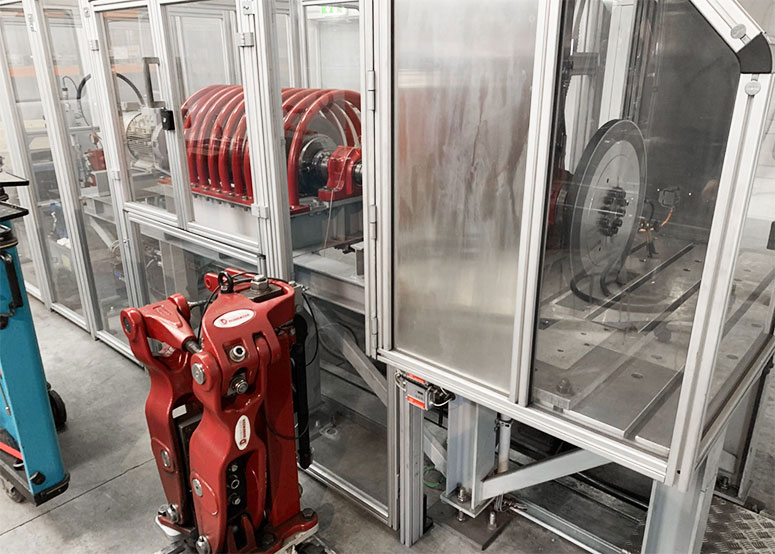Dellner Bubenzer, a manufacturer of high-performance disc and drum brakes, cylinders and accumulators for industries such as mining, is, once again, raising awareness of the importance of safety critical braking solutions.
The Dellner brand, the company says, has been synonymous with industrial braking and safety since Dellner Brakes was founded in 1941, but it has continually evolved, right up to and beyond the 2021 acquisition of Dellner Hydratech, the Danish supplier of high-end hydraulic systems, cylinders and accumulators for mining, wind, offshore, and marine applications.
The company says it has repeatedly delivered solutions to heavy-duty mining projects in recent years. In addition to its main market – material handling – the mining sector presents many challenges that require the company to respond with efficiency and precision, and produce targeted, tailor-made products.
“Mining is different to other markets, most notably because of the lead and project times in play, in addition to the demands placed on equipment at the point of use,” the company says. “Where a manufacturer of container handling equipment might complete production on a crane every single day, the largest mining companies…might be working to a site starting to mine a year from Dellner Bubenzer first being consulted. However, that point in time is non-negotiable and everyone has to deliver – on schedule and on budget.”
It is also not uncommon for component manufacturers to have service engineers on site for months at a time, which wouldn’t be the case in the material handling market, according to the company. And, while a lot of industries work to high duty cycles, mines are expected to be operational 24-hours-a-day, seven-days-a-week.
Mongolia, North of China, is just one of a number of country’s using Dellner Bubenzer’s solutions for mining. Here, the company referenced the supply of brakes for three gearless conveyor systems with an installed capacity of 2 x 5,500 kW each for a 7,100 t/h application in a copper mine.
The full scope of work included floating calliper brakes (model SFR50), brake discs, hydraulic power units, UPS, BCC3000 closed loop control systems, as well as the complete encoder technology.
The main parameters of the brake – pad wear, stroke (air gap) and brake pad temperature – are now continuously monitored, according to the company.
“The brakes stop the conveyor within 10 seconds in loaded or unloaded condition,” Dellner Bubenzer explains. “Depending on load, speed, etc, the HPU and control unit provide different braking levels and scenarios. The controlled braking process minimises the conveyor belt tension and reduces stresses in the connected equipment. The system is also able to perform the pre-programmed ramps and stopping curves after a power outage.”
Redundant controls and HPUs guarantee the highest system availability, while the environmental conditions required a compact setup of the brake units, the company says. The spring applied, hydraulically released, fail-safe brakes are able to equalise axial movement of the connected shafts.
Communication between the main PLC and BCC3000 happens via the PROFIsafe protocol, which integrates the relevant safety features while also monitoring the sub-functions, Dellner Bubenzer added.
Contamination prevention
High-end hydraulic cylinders and accumulators are central to Dellner Hydratech’s mining portfolio, the company says. These cylinders generate a pulling or pushing force, and are found, among other places, in earthmoving equipment at surface mines. Steering, bucket and lift cylinders can be found on a single wheeled loader. Accumulators, meanwhile, are a type of pressure storage hardware where an incompressible hydraulic fluid is held under pressure and applied mechanically.
An overarching concern with such technologies – where they are required to work in dirty, heavy-duty environments – is contamination. These systems have multiple components and, when they become contaminated, costly downtime can occur. In fact, over 70% of failed cylinders have broken down due to contamination and Dellner is contacted daily about inferior systems breaking for the same reason, it says.
All weld details must be optimised for high fatigue strength and to eliminate the risk of contaminating internal parts of the cylinder. Metal-to-metal gaps at welds must also be avoided, as dirt can be trapped and released when parts expand at high pressure.
Dellner says it recently improved the 800-hour lifetime of a cylinder by five times, ‘simply’ by removing the risk of contamination.
Dellner Bubenzer Germany is part of the company’s industrial business division, and is currently answering all enquiries regarding mining, supported by automation engineers, commissioning teams, and the firm’s research and development department. Sales, technical functions and commercial calculations all take place at the same facility too.
Dellner Bubenzer says it also recognises that proximity to the point of use is especially important to aftersales, locating its product development and manufacturing facilities across the globe to efficiently serve the mining industry. Presently, Dellner Bubenzer maintains manufacturing/service facilities and operational bases in several key regions, including Europe, Asia and North America. These global facilities are positioned to ensure proximity to major mining markets, facilitating streamlined production processes and prompt delivery of braking solutions to mining operations, wherever they might be, it says.











